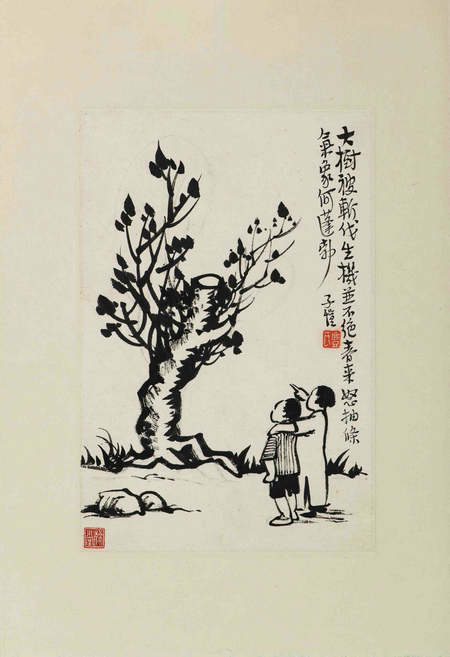
Feng Zikai. A Chopped Tree. Ink on scroll. Source:
War and Popular Culture. Chang-tai Hung 1994, 143 (Figure 37).
Feng Zikai was known for his skills as a cartoonist during the rise of Communist China. The layout of his works typically are done in ink on scroll, with a poem captioning on the side. As emulated in this painting, Feng was inspired by Western art; Feng gave up the traditional level of sophistication in the brushstrokes of classic Chinese paintings, rendering his works with simple layouts and clean-cut lines. As seen in A Chopped Tree, there is no use of the traditional ink technique of puddling. The work has minimal shading, with not much more than an outline and a few details to render each object. This emphasizes Feng’s ability to depict simple yet elegant moments in life. While Feng’s main goal was capturing the beauty of a brief tranquil moment in time, he also incorporated subtle critiques of social issues occurring in China into his work (Lin, 2018). A Chopped Tree is an excellent example of this strategy. Without understanding historical context, a viewer could see this ink brush painting as a comfortable moment for reflection. The work shows two people, likely a parent and their child, stopped along a path to look at a tree that has been partially cut down. The parent points upward and has their hand casually draped around the child’s shoulders, displaying comfort and nostalgia. The parent gesturing upwards towards the tree indicates that they are imparting wisdom upon their child. The poem on the side of the painting gives context to the life lesson that the parent is teaching: “A tree has been chopped down, but its instinct for life never dies. When spring comes again, it will grow and thrive.” This painting was made during the War of Resistance against Japanese Aggression (1931-45). Feng felt strongly against the Japanese threat towards China, and encouraged people to fight back (Hung, 1994). Contextually, this historical time frame gives meaning to the poem; the tree represents the well-being of China, and the part of the tree that has been chopped down represents the negative effects of the Japanese invasion. Though the Japanese have harmed China, when the war is over, China will be able to grow back and flourish, just as before. Feng’s use of a child in this painting represents the hope for redeveloping China in the next generation. The child represents growth and learning from the past. Feng intended for the story of the tree and it’s unyielding determination to grow to encourage the people of China to be determined, and continue the fight against the Japanese invaders.
References:
Hung, Chang-tai. War and Popular Culture: Resistance in Modern China, 1937-1945. Los Angeles: The Regents of the University of California, 1994.
Lin, Qi. Feng Zikai exhibitions offer insight into painter’s life. http://www.chinadaily.com.cn/a/201810/30/WS5bd7984aa310eff3032854a1.html.

